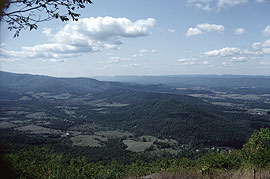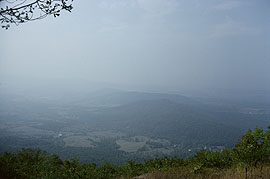Dangerous Ozone
Why is ozone so dangerous?
Oxygen is an element. The oxygen we breathe usually comes in pairs of atoms, or O2. Under certain conditions, some pairs of oxygen break apart, and each atom joins another pair to make ozone, O3. O3 is unstable and even more reactive than O2.
Ozone will react with living tissue. In plants, ozone can hamper photosynthesis and lower crop yield. In people, ozone can inflame delicate tissues in the lungs, leaving them open to asthma and infections. Children and elderly people are especially at risk from ozone exposure.

- Dickey Ridge, Clear
- On a clear day, visibility at the Dickey Ridge area of Shenandoah National Park can be 100 km (62 mi).
- Courtesy of the National Parks Service

- Dickey Ridge, Ozoned
- When pollution wafts in, visibility at Dickey Ridge drops to 5 km (3 mi).
- Courtesy of the National Parks Service
Ozone on the Move
Our National Parks are good places to get away from ozone pollution, right? Wrong! Because the atmosphere transports, urban pollution plagues retreats such as Shenandoah National Park, 75 miles west of Washington, D.C.
Ozone isn’t the only traveling pollutant. When gases from the burning of fossil fuels meet up with water in the atmosphere, they make sulfuric acid and nitric acid. These acids fall to Earth in rain, snow, or fog. They can kill fish in rivers and lakes, burn the leaves on trees, and dissolve limestone in buildings.
Wouldn’t it be perfect if we could pump the excess ozone in the troposphere up to the stratosphere to fill the ozone hole? Alas, there’s no way to trap tropospheric ozone. Even though it’s harmful, it’s still scarce—only about 50 molecules of ozone per billion molecules of air. And even if you could trap it, ozone is so unstable, it would react with other gases in the air before it could be pumped up to the stratosphere.
